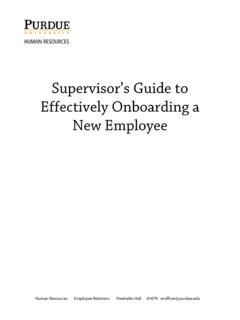Transcription of Community of Inquiry Framework - Purdue University
1 Purdue REPOSITORY FOR online TEACHING AND LEARNING Community of Inquiry Framework 1 What is it? The Community of Inquiry (CoI) Framework is a social constructivist model of learning processes in online and blended environments. The Framework is built upon three dimensions: presence is defined as the design, facilitation, and direction of cognitive and social processes for the realization of meaningful learning. This involves the (1) instructional design and organization of the course and activities, (2) facilitation of the course and activities, and (3) direct instruction presence refers to the ability to perceive others in an online environment as real and the projection of oneself as a real person. Social presence involves open communication, affective expression, and group cohesion. presence is the extent to which learners are able to construct and confirm meaning through sustained reflection and discourse.
2 The ultimate goal of the Community of Inquiry is to build a solid foundation of social presence and teaching presence to stimulate cognitive presence in a course. 2 Why is it important? Research has shown that there is a relationship between the three presences and students perceived learning, satisfaction with the course, satisfaction with the instructor, actual learning, and sense of belonging (see Akyol & Garrison, 2008; Arbaugh, 2008; Richardson, et. al., 2017). As depicted in Figure 1, the CoI Framework explains deep and meaningful learning online as occurring at the intersection of social, teaching, and cognitive presence Figure 1 Community of Inquiry Model (Garrison, Anderson, & Archer, 2000) 3 How to do it? Establishing teaching, social, and cognitive presence in an online course can be accomplished in a variety of ways. Here are some examples to get you started: Teaching Presence Facilitate students learning activity.
3 ( See Discussion Board Facilitation ) ( See Course Management and Learner Guidance ) Provide students with timely & supportive feedback. Provide students with explicit and redundant instructions for all course activities. Social Presence ( See Social Presence ) Project your teaching persona through announcements, emails, videos, etc.; these types of activities also model behavior for students. ( See online Teaching Persona ) Offer optional virtual office hours for students. This would be a good way for you to answer students questions and address students concerns throughout the course. Common tools include WebEx , Zoom , and Skype which offer free trials or limited free access options. online TEACHING AND LEARNING DIGITAL REPOSITORY Purdue REPOSITORY FOR online TEACHING AND LEARNING Create weekly check-in videos or announcements to recap the learning content and preview the course content for the following week ( , Camtasia).
4 Develop initial course activities ( icebreakers) to encourage the development of swift trust. Model & encourage the use of verbal immediacy behaviors in interactions with students (self-disclosure, share values, use salutations, self-reference for examples, acknowledgment, approval). Encourage students to share (related) anecdotes, experiences, and beliefs in online discussions. Design collaborative activities problem-solving tasks, projects, small group discussion. Cognitive Presence Identify big ideas you want students to take away from your course and develop major course activities around the assessment of those activities. Provide frequent opportunities for testing & feedback. Use self-testing, practice assignments, simulations & other interactive activities to support skill development & convergent thinking. Provide multiple representations of the knowledge you want students to learn and multiple activities for practicing desired skills.
5 Encourage experimentation, divergent thinking & multiple perspectives in online discussion through provocative, open-ended questions; encourage diverse points of view. Technology Tips and Tricks The following tips can help establish social, cognitive, and teaching presence. Utilize multimedia ( , images, audio, animation, and video) to create your learning content. Consider providing audio or video feedback for students if time allows. Audio and Video feedback is really helpful when you need to provide a more in-depth explanation of a concept, skill, or larger project to students. 4 Additional Resources The Community of Inquiry website Tools supported by Purdue ITaP WebEx : A web conferencing tool useful to host virtual office hours or record sessions. SnagIt : Screencast tool useful to give feedback and make announcements. Create, edit, and add images to screen captures of your computer.
6 Camtasia : Video editing and screencast tool useful to make tutorials and announcements. Add transition, highlights, titles to videos. VoiceThread : Collaborative tool allows file sharing and audio-based discussion threads. Other tools for feedback: Screencast-O-Matic : Create free screencast videos and add narration. QuickTime : Allows screencast and video editing. Kaizena : Allows audio feedback embedded in Google Docs. 5 References Garrison, D. R. (2017). E-Learning in the 21st Century: A Community of Inquiry Framework for Research and Practice (3rd Edition) . London: Routledge/Taylor and Francis. Garrison, D. R., Anderson, T, & Archer, W. (2000). Critical Inquiry in a text-based environment: Computer conferencing in higher education. The Internet and Higher Education, 2, 87 105 Huang, W. J. (2015, March). Be visible in the invisible learning context: How can instructors humanize online learning.
7 Paper presented at the 42nd Annual Federation of Business Disciplines, Association of Business Information Systems (ABIS) Conference, Houston, TX. Richardson, J. C., Arbaugh, J. B., Cleveland-Innes, M., Ice, P., Swan, K. P., & Garrison, D. R. (2012). Using the Community of Inquiry Framework to inform effective instructional design. In L. Moller & J. B. Huett (Eds), The next generation of distance education: Unconstrained learning (pp. 95-125). Boston, MA: Springer. 2020 Purdue University . This work is licensed under a Creative Commons BY-NC-ND International License . Written by Wanju Huang, Andrew Hurt, Jennifer C. Richardson, Karen Swan, and Secil Caskurlu Designed by Daniela Castellanos Reyes














